Beat this horse until it is dead and rotting
I love the taste of Barium in the morning. Good thing, too, since I’ve been getting a lot of it lately. For the uninitiated, Barium and Aluminum are the two main heavy metals which are suspected to be a major component of Chemtrails.
Chemtrails are a covert activity taking place in our skies whose purposes are unclear, although there are several legitimate theories as to the possible purpose(s). Planes are spraying a concoction on the American people (and in fact, all over the world) and all anyone needs to do to be sure is take their blinders off and look up. Many citizens have reported strange illnesses coinciding with the spraying of chemtrails, and some communities have even awoken to strange gunk and ooze over their cities after a night of spraying activity.
If you refuse to be convinced that a chemtrail differs from a contrail and consider the believers loonies, that’s your own bag.
But please check out the below photos. Retain your disbelief, but at least consider the enormous negative health effects from the immense air pollution in the following images.
A contrail:

A contrail is short for condensation trail. Water vapor released from the jet engine cools in the atmosphere and forms icy particles which leave a short trail. Typically the trail dissipates within a very short period – seconds to minutes. At certain altitudes and temperatures contrails can persist for longer periods of time, however the circumstances for this are not often met in the Iowa skies, where these images were taken. Furthermore, when one witnesses jets leaving normal contrails flying at the same altitude as jets leaving chemtrails at the same time, the difference becomes obvious.
A chemtrail:

A chemtrail is short for a chemical trail, because chemicals are being sprayed on us. A more scientifically accurate term for chemtrail may be an aerosol trail, but chemtrail is a better term for convenience purposes if nothing else.
Unlike contrails, chemtrails often persist for hours on end rather than dissipating. Small trails slowly expand and fill the sky. They tend to form a grid like pattern, with parallel and perpendicular lines visible. X’s are quite common. Chemtrail spraying usually begins in the early morning and lasts through the sunlight hours, although it has been documented to occur at night as well. Over time, the trails left by the jets spread across the sky. A typical spray day turns an otherwise clear blue sky into a gray haze. The aerosol spread from the chemtrails often forms artificial cirrus-type clouds. Odd striations and holes are commonplace in these formations.
A chemtrail sky:
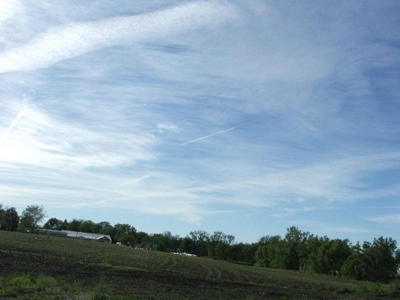
Chemtrails in action:
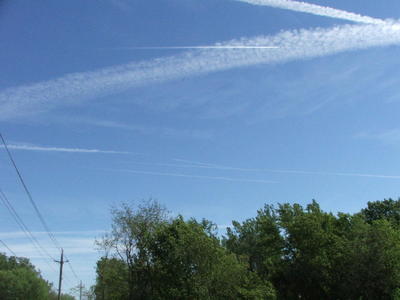
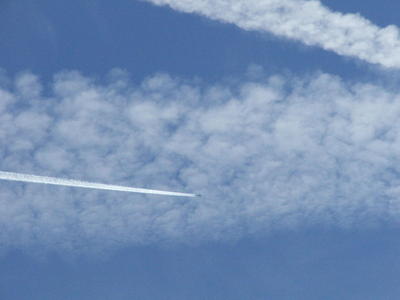
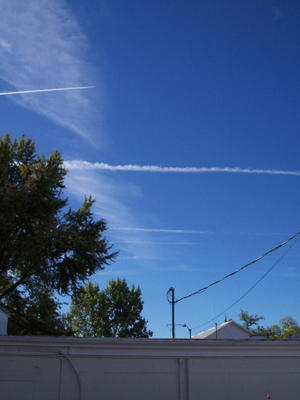
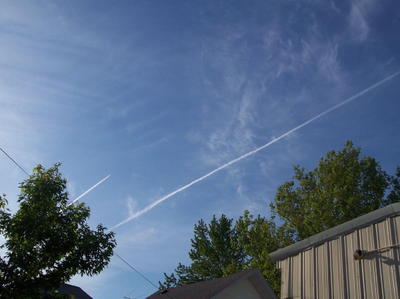
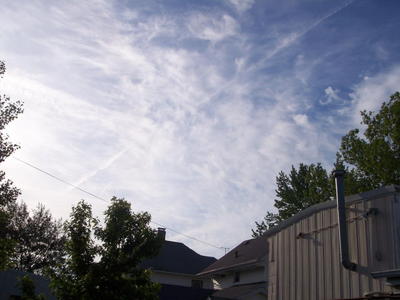
Further information on chemtrails can be found all over the Internet. I recommend http://www.carnicom.com as a good starting point, as well as http://www.weatherwars.info.
All photos by Mentalgongfu.

2 Comments:
077M:
The best of the telephoto shots were taken on a digital camera which I actually borrowed from a friend, so I'm not sure offhand of the exact specs, although I can find out in the near future. The majority of the images were taken with a little Kodak digital 5 megapixel, but the zoom on that model is nowhere near as good as I would like. A few of the images (such as the chemtrail sunset) were taken with 35mm on a Canon Z135.
I recently heard of the polarized lense attributes but have not yet done any experimentation. I've had my best results with digital over 35mm. If you stick with your current camera I would recommend you try some high resolution, although I would suggest a 3-5 megapixel might solve some of the problems you're having with the 1.5mp.
Although my 35mm prints have been less defined than the digital photos, I suspect that has more to do with the photo processing than anything else. I'd be curious to see what kind of images could be gleaned by someone who knows what they're doing in a darkroom.
It might also be interesting to shoot black and white film in a 35mm SLR using a red filter, which enhances clouds.
For traditional cameras, I think the key is to use the longest telephoto (zoom) lens you can afford, at least 300mm. For digital cameras you need at least 4-5 megapixels and 10X zoom, (equiv. to 370mm).
Post a Comment
<< Home